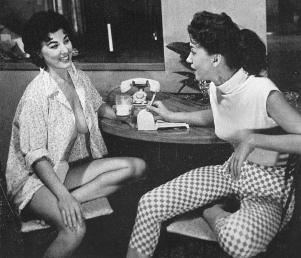
Photographer Jean Hidey (right) confers with one of her glamour models, Karen Stewart (1958).
Jean Hidey - Jean Hidey got her start as a photographer after first becoming a well-known burlesque performer in nightclubs such as The Near 'N Far in Los Angeles and then doing some modeling work with several glamour photographers. In one sense, she followed in the footsteps of other model-turned-photographers as Bunny Yeager and Eva Grant, and at the same time took the opposite route of models Doris Gohlke and Marilyn Wesley who first became popular glamour models and then went into burlesque.
Note: Doing the research for these photographer profiles can be a bit difficult at times, but in this instance I was fortunate enough to enlist the assistance of Jean Hidey's daughter, Sean, and much of the biographical information included on this page was obtained through a 90 minute phone conversation as well as several emails.
Jean was born in Webster City, Iowa to Albert and Elizabeth Porter on January 30, 1930. However, her parents' residence was actually in nearby Stratford, Iowa which at that time had a population of 699 - that number would remain nearly unchanged for the next 90 years (in 2020, the population reached 707!). Jean's actual birth name was Margaret Ann Porter. Her father Albert worked as a farm laborer and the family was quite poor. By 1935, Albert had moved his family to a rural area of Dunklin County, Missouri and later to Union Township in Dunklin County. Margaret hated the poor farm lifestyle she had grown up in as well as her given name so when she reached the age of 20 she took off for Hollywood and created a new identity for herself: she would now become known as Jean Smyle (pronounced "Smiley").
In Los Angeles, while living in a small rental apartment with another girl, Jean took elocution lessons to help her get rid of her rural Missouri accent. She then quickly went about trying to break into some form of show business. Jean eventually settled on burlesque dancing and in late 1952 became a working stripper. But she felt that her act was unprofessional. "I had enthusiasm" she said at the time. "I got my clothes off all right, but it always looked as if I'd never done it before." So, Jean sought out ex-stripper Miss Lillian Hunt who had her own stripper school at the New Follies Theater. In addition to teaching Jean about costume sewing, a few ballet principles, stage presence and burlesque stripping, Miss Hunt also gave Jean a new stripper name - one that she felt would increase her glamour: "Venus, the Body". By March of 1953, Jean was already being featured in newspaper articles, including the one below about Lillian Hunt's "School for Burlesque".
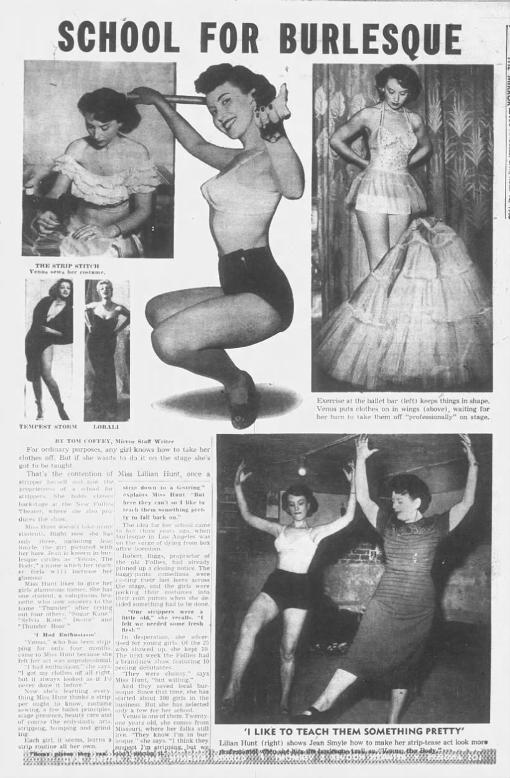
Jean soon became well-known on the burlesque circuit in Los Angeles. Of course, a burlesque performer always needs musical accompaniment and in early 1953, the multitalented musician Hal Hidey became her piano player. The two hit it off right away and seven months later (Aug. 20, 1953) they were married in a small ceremony at City Hall in LA. On that very same day, the following article appeared in The Los Angeles Mirror.
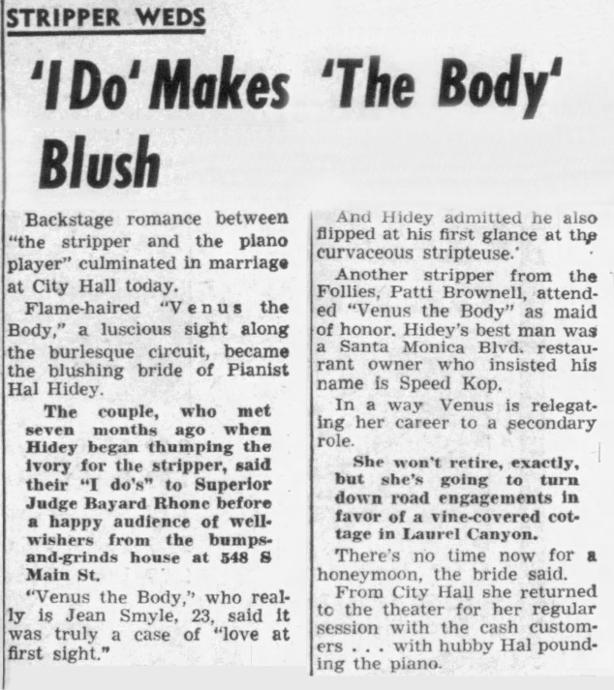
After the marriage, Margaret Porter aka Jean Smyle, became known as Jean Hidey. The couple made their home at 2184 Laurel Canyon Blvd., which is where they would remain for several years. During the marriage, the couple would have two children together - a son who was born in October of 1954, and a daughter who arrived in January of 1956.
As time progressed, Jean was inspired by what Lillian Hunt had done with her stripper school, so she started her own striptease school in Los Angeles. In the October 7, 1957 edition of a Wilmington, California newspaper (the Daily Press Journal), there was an article about Jean's school. Jean was quoted as saying "Burlesque can't even be classified as entertainment any more. Ninety percent of the girls stripping today are short, saggy and fat. Because of them, burlesque is a dying art, and we hope to bring it back." She also noted: "We're attempting to bring graceful dancing back to strip-teasing. The day of the girl who walks on a stage just to peel off her clothes is over. We'll still strip, of course - but with class."
The next year, in November of 1958, Jean took part in a practical joke (set up by Jack Lemmon and Tony Curtis) on the set of the movie "Some Like It Hot", directed by Billy Wilder. In one scene, a gangster was supposed to pop out of a large cake with machine gun in hand and mow down George Raft and a couple of his sidekicks, but instead, Jean Hidey popped out, either nude or very scantily dressed. Director Billy Wilder staggered with surprise as the cast and crew broke into singing "For He's a Jolly Good Fellow". When this stunt was reported in the Pomona Press Bulletin, they also noted that Jean was a Moulin Rouge showgirl and a former stripper, so it's my guess that Jean quit her burlesque gig sometime in 1957.
However, before she quit for good, she was filmed doing her burlesque act and this footage was to be used for a scene in a "cinema verite" film called "The Savage Eye", which was released in 1959. Since the movie was shot over a four year period, it's not clear when the footage of Jean (Venus, the Body) was actually filmed. However, the location for the shoot seems to be the Near 'N Far nightclub in Los Angeles. Below is a still of Jean from the film.
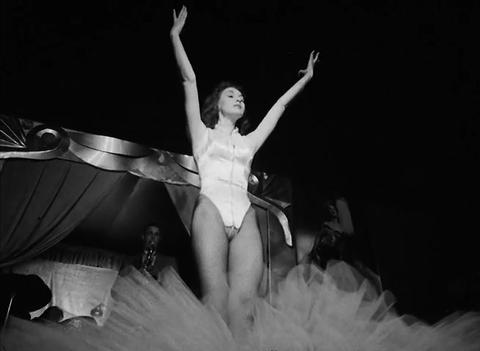
In addition to being featured in the film "The Savage Eye" (which can be viewed on YouTube for free), Jean would also have a small role in the 1960 film "Studs Lonigan" as a burlesque stripper.
While she was still working in burlesque at the Near 'N Far nightclub, she also began modelling for some glamour photographers. One such photographer, William Karl Thomas, who was a collaborator of comic Lenny Bruce, credits himself with helping Jean get her start in professional photography. In his book "Lenny Bruce: The Making of a Prophet", Mr. Thomas writes: "I had been doing glamor photography with some of the dancers at the Near and Far, including a beautiful redhead named Jean Hidey who worked under the name "Venus the Body." Jean's husband, Hal Hidey, was a musical arranger for the Spike Jones Show and a vocal coach for leading vocalists. Jean was interested in photography and later became a professional glamor photographer herself under my tutelage."
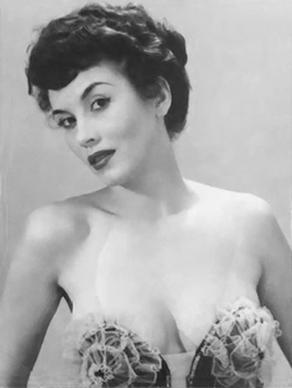
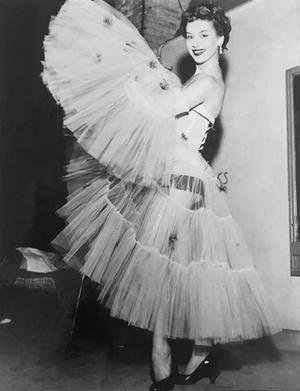
Above: Two glamour photos of Jean Hidey that were taken by unknown photographers. Photos courtesy of Sean Hidey.
In the pursuit of her photography career, Jean began acquiring all sorts of photo equipment including a large format camera, and rented a modest studio at 1030 N. Western Avenue. She would begin to photograph glamour models herself as well as some television and movie stars who had been acquaintances of her musician husband, Hal Hidey. Her two young children were also the subject of her photography.
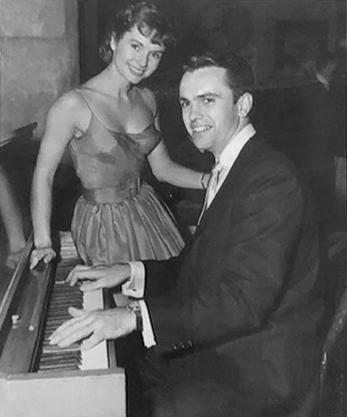
Jean's husband Hal Hidey at the piano
with actress Debbie Reynolds looking on.
Photography by Jean Hidey.
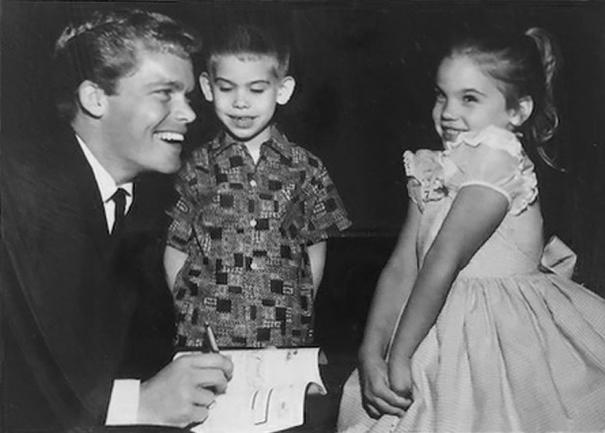
Television star Doug McClure was captured by Jean's camera as he posed with Jean's two young children. Photo courtesy of Sean Hidey.
Regarding Jean Hidey's glamour photography - an article entitled "Venus Finds a New Body", in which she photographed model Karen Stewart, was published in the October 1958 issue of Modern Man magazine. To view the four main photos in the pictorial, please click here.
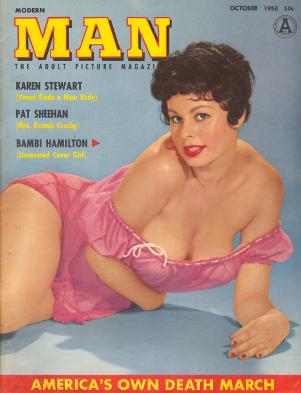
The cover of the Oct. 1958 issue of Modern Man, which featured glamour photos taken by Jean Hidey.
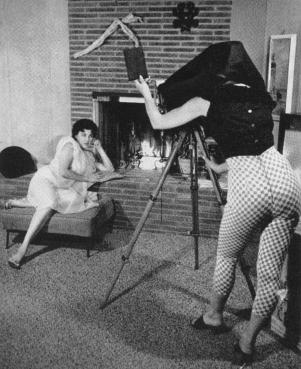
Jean Hidey, who appears to be using a 4x5 View camera to photograph glamour model Karen Stewart.
Camera equipment used by Jean included a 4x5 View camera (seen above) and a medium format camera, probably a Rolleiflex. Jean also did her own darkroom work and may have had a darkroom at both her studio on N. Western Avenue and her home in Laurel Canyon.
In 1962, Jean virtually stopped taking photographs and in 1963 Jean and Hal Hidey would divorce. After the divorce, Jean decided to become a real estate investor. She initially bought a fourplex and during this time (and for several years) she also worked for the Hearst Corporation, taking phone calls from people who wanted to place ads in their newspaper. Jean would then work on the weekends updating the fourplex units, sometimes enlisting the help of her two children. After she had stopped working for the Hearst Corporation, Jean obtained a real estate license and started doing real estate sales while trying to flip her own properties in her spare time. Jean would later buy a property in Sierra Madre that had 6 cottages and a tri-plex on it. She would fix up the units herself and then later sold the property at a huge profit.
On February 1, 1975, Jean married a man named Michael Quade (who she had known for about four years), but the marriage ended in divorce in January of 1977. However, following the divorce, she and Mike continued to live together for another year or so and they both worked on improving the Sierra Madre property that she owned. Many years later, while Jean was receiving rental income from her properties, she did a lot of traveling overseas. On one particular trip in 1998, she traveled to England, Denmark, Sweden, Finland, Russia, Poland, Germany and Holland.
Throughout her life, Jean was always a student and took many continuing education courses. Because of her quest for knowledge she was a voracious reader and always seemed to have a book in her hands. She even read encyclopedias cover to cover! Jean also loved to write and taught creative writing courses at some local community colleges. In addition, she submitted many of her short stories to Readers Digest magazine, using the name Margaret Hidey (she used her birth name Margaret for both her writing and her real estate dealings). Jean was also fascinated by religions and studied several of them over the years. In her 50s, she even tried standup comedy for a while, performing in front of audiences at some of the colleges where she taught.
During her later years, Jean's work in burlesque was not entirely relegated to the past, since she stayed friends with one performer from that era - Marcia Edgington. She also kept a portfolio of some of her modeling work, as well as some of the photos she had taken during her photography career.
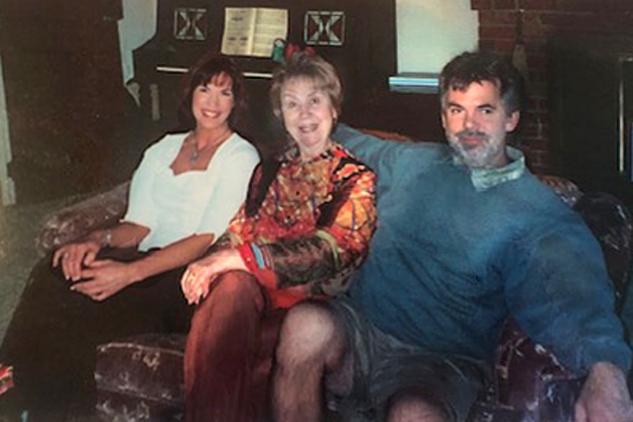
Jean Hidey at around the age of 70 (circa 2000) surrounded by her two children - daughter Sean on the left and son Stephen on the right. Photo courtesy of Sean Hidey.
Sadly, at the age of 79, Jean developed cancer and it took her very quickly. She passed away on Sept. 23, 2009. Jean Hidey was cremated and her ashes were scattered around the trees at her home on Wheatland Avenue in Sunland, California.
As a side note, Jean's first husband Hal Hidey (born May 18, 1925) remarried in 1982. Hal had a varied and illustrious career in music, composing for various television shows (The Jerry Lewis telethon, The Jeffersons, game shows such as Tic Tac Dough, The Joker's Wild, etc.), as well as acting as a vocal coach, orchestra leader, studio musician, musical director, and recording artist (the 1958 LP "Barroom Music with a Broad Appeal"). He passed away from cancer on July 5, 2014 at the age of 89.
Very special thanks to Sean Hidey for her help in supplying most of the biographical details included in this profile.
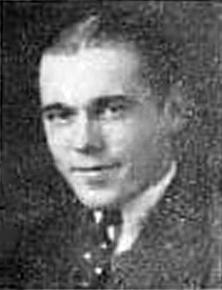
Jack Edward Drebert in 1928. When this photo was taken, he was either 17 or 18 years old.
Jack and Jean Drebert - This husband and wife team is probably most well- known for their photo of 1950s glamour and figure model Madeline Castle that appeared as the centerfold in the October 1954 issue of Playboy magazine, but their images also appeared in several other publications of the 50s. The couple was a bit older than many of the glamour photographers of the period and since they both passed away at a relatively young age, they virtually disappeared from the glamour scene just 5 or 6 years after their centerfold of Miss Castle was published in Playboy.
John Edward Drebert was born to John F. and Nora A. Drebert on April 25, 1910 in the small town of Boomer, West Virginia. He attended Charleston High School and upon graduation in 1928, he went on to higher education at Ohio State University (Columbus, Ohio). At Ohio State, he was a member of the Phi Sigma Kappa fraternity. After John graduated from OSU four years later, he stayed in Columbus and by 1935 he was working as a salesman for the Remington Rand Corporation. At some point during the next two years, he met Jean Cameron (born Jean Morris on Oct. 4, 1910 in Birmingham, Alabama), a recent widow. The two were married on April 10, 1937 in Columbus and very soon were back in Boomer, West Virginia where John worked for a time as Boomer's postmaster. After resigning from that position in January of 1938, he began working as an assistant manager of a theatre (his father, John Francis Drebert, who had been in the theatre business since at least 1920, was the manager and mother Nora was a cashier).
In 1940, at the age of 30, John registered for the draft and on December 27, 1943 he was enlisted as a private in the Army at Huntington, West Virginia. Sometime in 1946, Jack and Jean moved to Los Angeles. In the 1950 census, Jack and Jean, along with Jack's mother Nora were all living in the same household in LA (John's father, John F. Drebert had died on January 5, 1950), and Jack's occupation was listed as photographer (Commercial and Portrait photography). Sometime within the next 3 years, Jack and Jean would photograph Madeline Castle and one of their studio photographs of her would be chosen to appear in the October 1954 issue of Playboy.
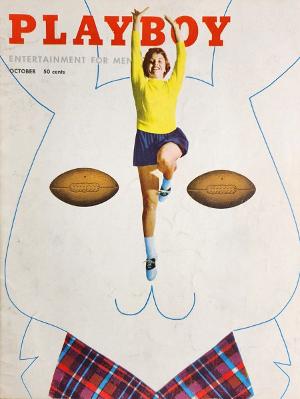
The cover of the October 1954 issue of Playboy magazine.
Currently, I have no knowledge of the couple's camera equipment or how long Jack and Jean had been involved in photography, but several of their other photos of Madeline Castle appeared in some art and men's magazines of the 1950s. Eight photos of Madeline that were taken at the same time as the Playboy centerfold were published in Figure Studies Annual Number Six, and two beautiful nude glamour photos of Miss Castle posing in front of a fireplace were featured in two separate issues of Modern Man (in the Modern Art for Men gallery). Two of their photos of model Shirley Kilpatrick also appeared in the Modern Art for Men sections of Modern Man (April 1958) and Modern Man Quarterly (Spring 1959). They also had non-nude photos of model Mary Lou Devore published in the March 1952 issue of Glamorous Models and one of their other models was featured in the May 1953 issue of Cover Girls Models. Other periodicals that featured the nude photography of Jack and Jean Drebert included Figurette Annual Number One, Figure Studies Annual Number Eleven, Figure Quarterly Winter 1959, the July 1953 issue of Amateur Art and Camera, which featured the same eight photos of Madeline Castle that appeared in Figure Studies Annual Number Six, and the January 1954 issue of Amateur Art and Camera, which included eight studio figure studies of an unnamed model.
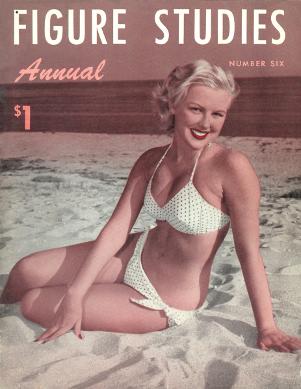
Figure Studies Annual Number Six which featured eight studio photos of Madeline Castle by Jack and Jean Drebert.
In 1952, the couple was living at 5844 Compass Dr. in Los Angeles, but by 1956 they had moved into a recently built home at 1143 Shasta St. in West Covina, a suburban city located 19 miles east of Downtown Los Angeles.
Tragically, just a few years later, on October 16, 1958, Jean Drebert died from ovarian cancer that had spread to other parts of her body. She had just turned 48 years old and had elected to have her body cremated. At the time of Jean's death, Jack's occupation was listed as "Transportation Office".
Jack Edward Drebert passed away less than 3 years later, on July 16, 1961 at St. Luke Medical Center in Pasadena. He died of Congestive Heart Failure, brought on by Cor Pulmonale (enlarged right ventricle of the heart due to a lung condition) and Chronic Pulmonary Fibrosis, which he had had for 3 years. Another significant condition that he suffered from was Cirrhosis of the Liver. Jack Drebert was only 51 years old at the time of his death and on July 18, 1961 he was entombed in the Pasadena Mausoleum.
I hope to have more information on this couple in the future.
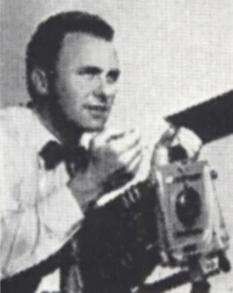
Fran Hunt - Fran Hunt was a glamour photographer who started out as a bit of a troubled young man, but seemed to have beaten his problems to become fairly well-known in the Southern California glamour scene. In addition to shooting glamour and figure studies (which would appear in periodicals such as Modern Man and Figure Quarterly), he also did commercial photography, photographed brides for wedding announcements, and shot numerous images that were used for color postcards on the West Coast.
Francis Steen Hunt was born on April 24, 1924 in La Habra, California to John Mitchell Hunt and Mary Frances Hunt. In the 1940 census, as a 16 year old, Francis was working as a kitchen helper at the Los Angeles Sanitarium. In 1942, at age 18, Fran registered for military service while living with his mother (Mary) in Arlington, California. On March 13, 1943, after having completed 4 years of high school, Fran enlisted in the military with the rank of private.
Fran's interest in photography originally started while he was in high school, where he would film sporting events. When the films were developed, they showed more of the curvy majorettes than the actual athletes, which was how he got into his "delightful" pastime of photographing women. His interest grew even stronger in college where he found the girls to be more available. But before Fran's career in photography became more serious, he suffered a setback in his mid 20s when he spent some time in a mental hospital. In the 1950 census, when he was 26 years old, Francis S. Hunt was listed as a patient at the Napa State Mental Hospital. However, he seemed to have overcome his problems because during the next year (1951), he married for the first time. His bride, Bonnie Jean Vandeusen, became his principal model and his photo work with her helped to take his photography to the next level. In fact, the year after they were married, Fran submitted a glamour photo he had taken of his wife to Cover Girls Models magazine and it was published in the Pictures from Readers section of the June 1952 issue (see below).
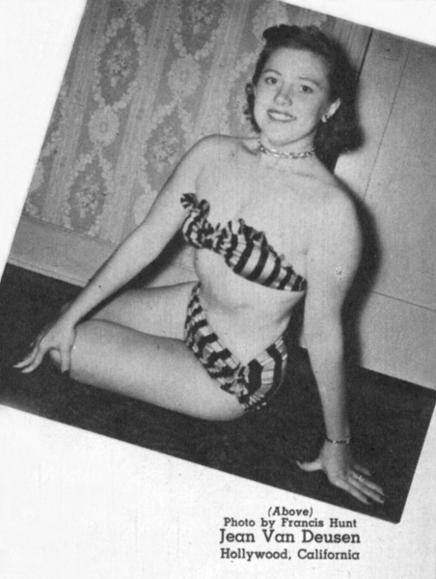
Fran would later go on to shoot some of the popular glamour and figure models of the 1950s, including Jennie Lee and Patty Conley. Regarding his camera equipment, Fran often used a 4x5 Graphic View or Speed Graphic.
A few of the late 50s magazines that Fran Hunt's figure photography appeared in were Figure Quarterly Summer 1958 (which featured an 8 page portfolio of his work) and Modern Man June 1958 (which included a two page color figure study of Patty Conley in the Modern Art for Men section).
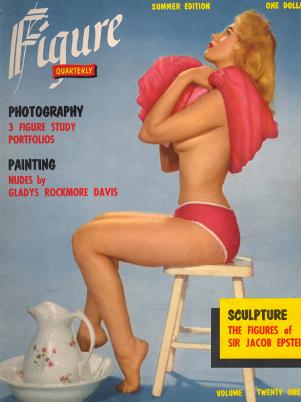
Figure Quarterly Summer 1958, which featured an 8 page portfolio of Fran Hunt's figure work. Cover photo by Arnold Rubenstein and Art Messick.

The June 1958 issue of Modern Man magazine, which included a two page figure study of model Patty Conley by Fran Hunt. Cover photo of model Iris Bristol by Russ Meyer.
During the early 60s, Fran Hunt had a photography studio in Alhambra, California and his wife Bonnie worked alongside him until August of 1966, when the two divorced (after 15 years of marriage). Two years later, in July of 1968 (while living in Laguna Beach, California), Fran married a 19-year-old model from Ogden, Utah named Christine Emma Rose. Christine attended Hollywood Beauty College in LA, which was likely where they met. The new Mrs. Hunt was born on August 9, 1948 so there was a 24 year age difference between them. During the 1970s, the pair became well-known for judging various beauty contests, including the Miss Palm Springs pageant. Below is a newspaper photo of Fran and Christine from 1971.
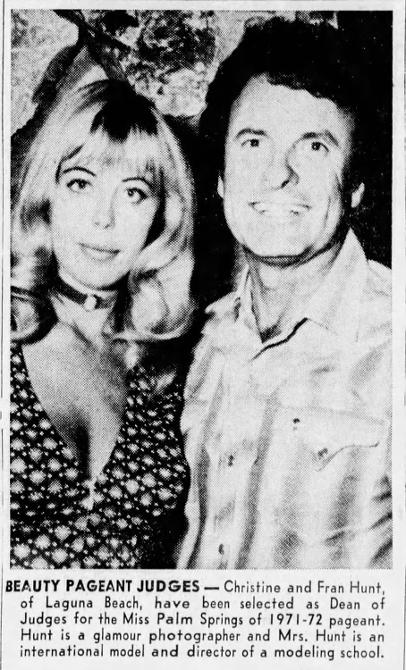
Sometime in the late 70s or early 80s, Fran and Christine moved to Chula Vista, California and then later to San Diego. Although I haven't yet found any information on whether Fran continued with his photography in San Diego, I did find the below photo of him (from Ancestry) that was taken in August of 1981.

While searching various records on Ancestry, I discovered that both Fran and Christine died on the same day (May 21, 1993) or within one day of each other (since a few sources say that Fran died on May 22, 1993). I ran through several scenarios where a couple could die together and was about to order Fran's California death record when I found an entry on Ancestry which mentioned that Fran (and presumably Christine) died as the result of a traffic accident in Ensenada, Baja California, Mexico. The person who wrote the entry appeared to have been a relative of Fran's so I assume the information is correct.
Hearings on the petitions to administer the estates of Francis Steen Hunt and Christine Emma Hunt were held on August 16, 1993 in San Diego, but I have been unable to find out whether their bodies had been cremated or if they were buried in a cemetery.
If any readers have additional information on Francis and Christine Hunt, please send me an email.
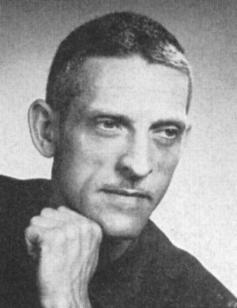
Edward Canby - Edward Canby was a photographer from Dayton, Ohio who began photographing nudes in the 1940s and his figure studies would later be published in such mid-50s magazines as Figure Photography Annual Volume Seven (alongside the works of Zoltan Glass, Jack Howard, Joan Craven, Andre de Dienes and Peter James Samerjan). In the very early 50s, Edward moved his family to Palm Springs, California and the following year (1952), he began dabbling in a different artistic medium - paint. In 1961, the Canbys had moved again, this time to Sedona, Arizona and by this time, Edward was almost exclusively working as a painter.
Edward Canby was born in Dayton, Ohio on June 16, 1908 and sometime in the 1930s, he developed an interest in photography. In 1939, he married Frances Boyd (born Dec. 15, 1916 in Bloomfield, New Jersey) and after returning from their wedding trip, the two temporarily lived with his parents until they could move into their own home at 43 Stoddard Avenue in Dayton. At that time, Edward was working as the manager of Dayton's Malone Camera Store. Some of Edward Canby's photographs would soon be published in The American Annual of Photography Volume Fifty Six (1941), and that same year, Edward and Frances would welcome their first child - daughter Judy. In 1943, they would add to their family with twin sons named Thomas Boyd Canby and Richard Boyd Canby. Around this time, Edward opened Edward Canby Studio in Dayton and he would also occasionally act as a judge in photographic contests held in the city. Edward would again have his work published in a national magazine when in the March 1949 issue of Popular Photography, one of his photos of his wife (Frances) appeared inside the magazine.
In 1951, Edward Canby moved his young family to Palm Springs, California, and opened a studio and picture framing/arts supply shop there. By 1954, he was displaying his oil paintings in his studio, along with his photographic prints. The Canby family would spend summers in their cabin in the wilds of Dubois, Wyoming, and while there in 1954, Edward won the adult sweepstakes first prize at the sixth annual Wind River Valley Art Exhibition of Paintings and Sculpture. He won both first and second awards in the landscape division, with his paintings of "Cold Roast Beef" and "Abandoned". Canby said at the time that the awards came as a surprise as "I only started dabbling in paint about a year ago, and have had no lessons."
At the same time Edward Canby was becoming well-known for his paintings, his photographs of nudes were appearing in magazines such as Figure Photography Annual Volume Seven. Four of his studio figure studies appeared in the magazine as well as a lengthy article written by Canby describing the techniques used when photographing the nude. With regard to choosing props, he wrote: "...it is interesting to select those which are in direct contrast in basic form and structure to the softness and roundness of the female figure. By emphasizing the very obvious structural differences between the two, you can give added emphasis to the figure. A modern type angular black iron chair - with its cold, straight, formless parts - would be a good example."
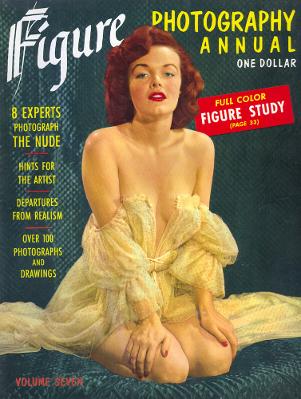
The mid-50s magazine Figure Photography Annual Volume Seven, which featured a selection of nudes by Edward Canby.
At around the time the above magazine was published, an image of Frances and the Canby children (taken by Edward Canby) appeared in the May 12, 1956 edition of The Desert Sun (Palm Springs) to commemorate Mother's Day.
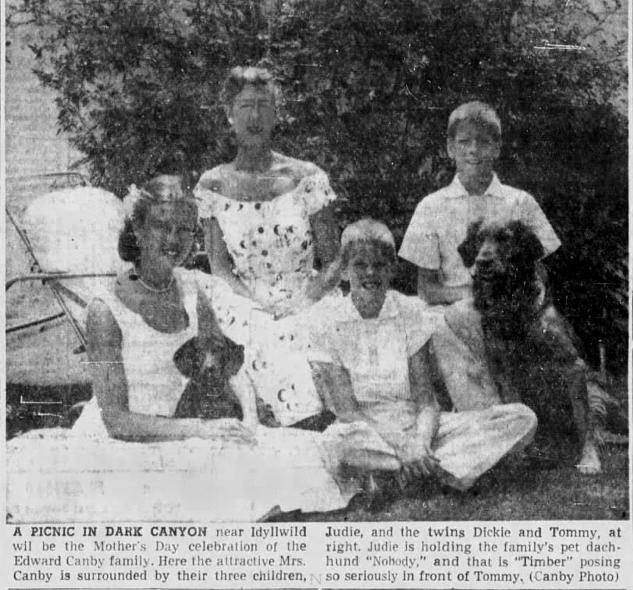
In 1961, after ten years of living in Palm Springs, Edward Canby and family moved to Sedona, Arizona. After the move, Edward Canby's creative energy was directed almost exclusively toward paintings. In a 1968 newspaper article about a Canby exhibition being held in Lubbock, Texas, they mentioned some of Edward's other accomplishments over the years: "Canby, a former professional photographer who started painting in 1952, is a graduate of Dartmouth College and was elected an Associate of the Royal Photographic Society of Great Britain and a Master of Photography in the Professional Photographers Association of America. His paintings lean to fantasy done surrealistically with a realistic touch." "Since I paint from my imagination, I can paint anywhere," he says. At this Lubbock exhibition, Edward Canby displayed oils, pastels and water colors.
Both Edward and Frances would stay in Arizona for the remainder of their lives. Edward passed away on April 21, 1990 in Sedona at the age of 81. Frances died over seven years later on August 3, 1997 in Sun City West. She was 80 years old.
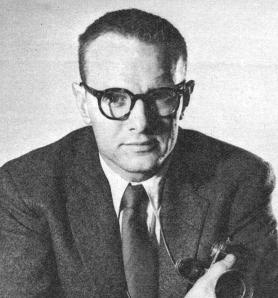
Portrait of Paul Duckworth taken circa 1956 and published in Charm Photography No. 4.
Paul Duckworth - Paul Duckworth was an award-winning New York photographer who shot a variety of genres, but he most often used people as his main subjects. All of Paul's photos had a human interest aspect to them whether he was photographing The Boston Pops, The New York Philharmonic, Grace Kelly (he was one of many photogs who captured images of her wedding in Monaco), musicians such as Louis Armstrong and Benny Goodman, people on the streets of New York, children at play, or even professional models. In this profile, I will predominately deal with the last category.
I first became familiar with the photography of Paul Duckworth when I began collecting the Fawcett photo books Good Photography, Candid Photography, Salon Photography and Prize Winning Photography back in 2007. The editions that I sought out were almost exclusively from the 50s and 60s as that was the era I was most interested in (yearly editions of Good Photography had been published since at least the late 30s). I had been wanting to write a profile on Mr. Duckworth for several years, but didn't have any knowledge of his later years until just recently when I contacted his youngest daughter.
Paul Junior Duckworth was born on July 12, 1920 in New Castle, Indiana to Paul Jones Duckworth, who worked as an auto mechanic, and Merle Duckworth, a housewife. Paul had three sisters - Carrie, Janis and Jini, and Jini would herself become a professional photographer of some renown. When Paul was a child, he seemed to have had a bit of a rebellious streak because, according to Charm Photography magazine, he ran away from home at the age of 12 to join a travelling musical troupe. At 15, he returned home to finish high school, and to please his father he went on to engineering school. However, he also studied art at night to please himself.
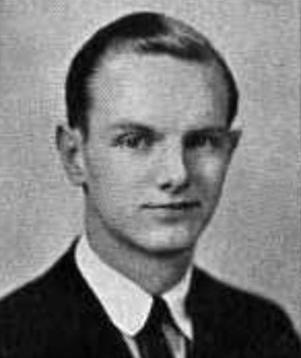
Photo of Paul Duckworth from 1940 when he was around 19 years old.

Paul Duckworth painted this portrait of pianist and composer Sergei Rachmaninoff while he was still in his early 20s.
Then, one day Paul bought a Brownie camera and found a whole new world. After moving to Manhattan and buying a Leica (35mm rangefinder), he began to shoot everything in sight in hopes of improving his photographic skills. Paul eventually began getting jobs as a photojournalist and would travel all over the globe on magazine assignments. At one point, he was ducking bullets while covering the war in North Africa, and at another he was basking in the warm Mediterranean sun. Alternating between his studio photography in New York City and his overseas magazine assignments, he also found time to submit his New York photographs (including his nude studies) to the Fawcett photo digests. Between 1955 and 1967, he submitted well over 50 of his images to these popular photo books, and a listing of many of the editions that featured his work can be found by clicking this link.
In Paul's role as a trusted photographer for some important New York institutions, he met and became friendly with several luminaries. One such man was conductor and composer Dimitri Mitropoulos, who between 1951 and 1958, was the music director (conductor) for the New York Philharmonic.
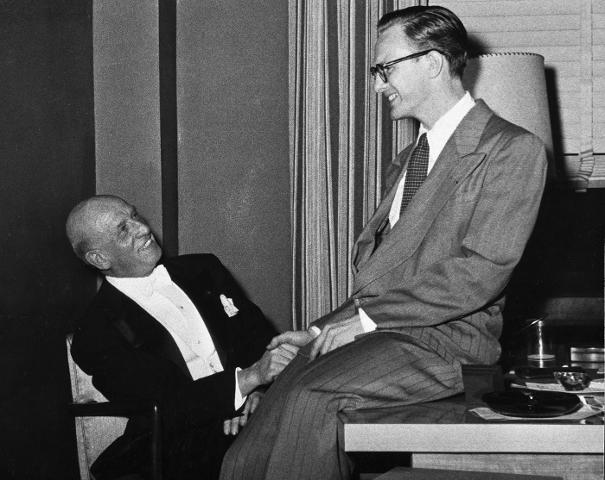
New York Philharmonic conductor Dimitri Mitropoulos seen posing
with photographer Paul Duckworth in the early to mid 50s.
In 1956, three of Mr. Duckworth's portraits of women were featured in Charm Photography magazine (No. 4) and in the May 1956 issue of U.S. Camera, one of Duckworth's nudes appeared alongside a photo by Andre de Dienes and both photos were cited as examples of the proper use of lighting. He also had a four page pictorial in the Autumn 1956 issue of Classic Photography (called "The Lady or the Tiger") and several of his nudes were featured in Figure Quarterly Volume Thirteen in an article about adding texture effects to your photos. By the late 50s, Paul Duckworth's photographs of models began appearing in men's magazines. For the February 1958 issue of Escapade, Paul shot a four page pictorial featuring candid B&W images of French stripper, actress and model Rita Renoir. Paul was also one of the first photographers to capture Lisa Varga (real name Rosalie Ascenzi, 1938 - 2018) on film and his photos of her were published in the June 1958 issue of Escapade. Paul was so taken with Miss Varga that he asked if there were any more like her at home. It turned out that she had a younger sister named Marion, and that led to her and Paul meeting. After several months, Paul and Marion were married and she would not only model for him, but she ran his Manhattan photo studio. In a 2011 interview, Marion was quoted as saying "I did everything from being his darkroom assistant and stylist to being his muse. He tried to teach me photography, but I wasn't interested." (Note: Although Marion claimed to not have been interested in learning photography, she is credited with being the photographer of two very fine images that were published alongside Paul's own photos in the 1964 editions of Salon Photography and Candid Photography - see the link at the end of the previous paragraph).
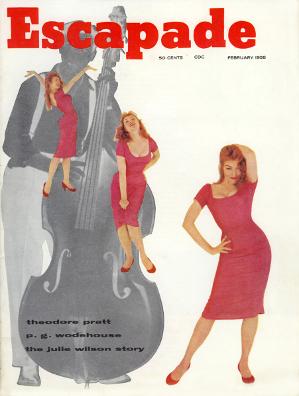
The February 1958 issue of Escapade which featured photos of Rita Renoir by Paul Duckworth. Cover photo by Ormond Gigli.
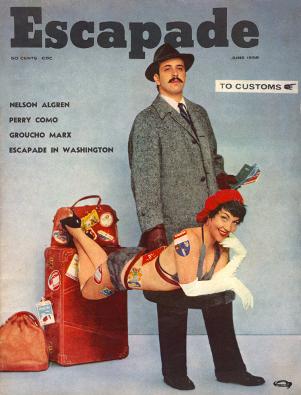
The June 1958 issue of Escapade with a five page pictorial of Lisa Varga by Mr. Duckworth. Cover photo by Herb Flatow.
Also in 1958, an eight page portfolio of Duckworth's figure studies was published in Volume Twenty One of Figure Quarterly (Summer Edition). Paul Duckworth's artistic nudes would also be featured in the Modern Art for Men section of Modern Man magazine during the late 50s. Issues included November 1957, May 1958, June 1958 and June 1959 (which showcased two of his images). Two more of his nude studies were featured in the Winter 1959 edition of Modern Man Quarterly.
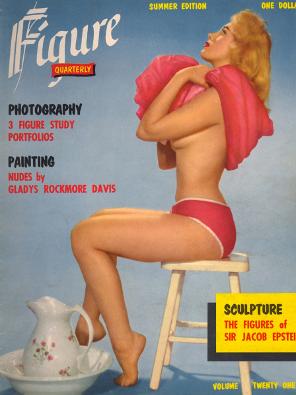
Figure Quarterly Summer 1958 which featured an eight page portfolio of Paul Duckworth's photography. Cover by Arnold Rubenstein and Art Messick.
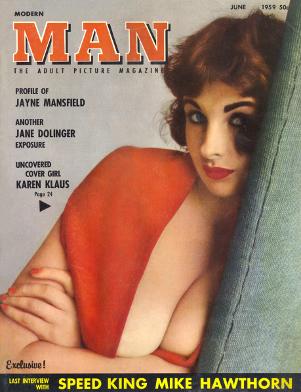
The June 1959 issue of Modern Man which featured two images by Paul Duckworth in the Modern Art for Men gallery. Cover photo of Karen Klaus by Mario Casilli.
Paul was also the author of photo books. His first, "Experimental and Trick Photography", was published in 1961 by Universal Photo Books and featured a photo of his wife, Marion, on the cover. That same year, he supplied all of the images for Mildred Stagg's book "The Nude in 101 Moods" (also by Universal Photo Books), so he could be considered a co-author of that book. In 1975, Mr. Duckworth authored "Creative Photographic Effects Simplified" which was published by Amphoto. Paul also contributed to photography magazines. From the years 1962 to 1965, he was a featured photographer for U.S. Camera and penned several articles for the magazine.
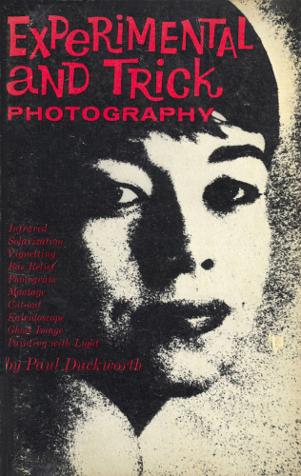
Paul Duckworth's first book "Experimental and Trick Photography" was originally published in 1961, but was reprinted in 1964, 1966, 1967 and 1969.
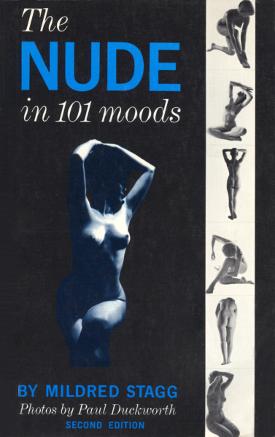
"The Nude in 101 Moods" by Mildred Stagg featuring photos by Paul Duckworth. The first edition was published in 1961, 1963 and 1965 with a second edition printed in 1975.
Camera equipment used by Mr. Duckworth during this time consisted mainly of the 35mm Nikon and the medium format Rolleiflex. He preferred Ilford film when shooting B&W and often used HP3 and FP3 which he developed in Microphen. As the title of his first book suggests, Paul enjoyed experimenting with his photographs. One method, that of sandwiching two negatives together in the negative carrier of the enlarger to create a composite image, had been used to great effect by Andre de Dienes and Paul created some fine images using this technique as well. As an example, the photographer would sometimes take a photo of some clouds or a seascape and another of a woman's face and sandwich the two negatives together and print them. What you invariably got was a dreamlike fantasy image. Another experimental device was to add patterns or textures to your photographs. Two ways of doing this would be to either sandwich the textured/patterned material with the negative or place it directly on the photographic paper before making the exposure. There are countless other tricks that can be done while printing with an enlarger.
In August of 1959, almost a year after they were married and began working together, Paul and Marion welcomed the arrival of a baby girl named Leslie. Mother and daughter would be featured in some of Paul's photos soon after the birth, and as time passed, Marion even started using Paul's cameras to take B&W photos of Leslie herself.
Regarding children, Leslie was not Paul's first child. He also had two children from a previous marriage - a son named Paul (b. 1942) and a daughter named Jennifer (b. 1944). Paul Jr. also developed a keen interest in photography and would occasionally visit his dad's studio in Manhattan during the 70s.
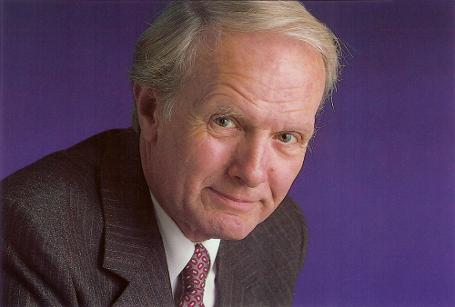
A portrait of Paul Duckworth that was taken in the 1970s.
Paul and Marion Duckworth continued operating their studio on 23rd Street in Manhattan for 22 years, but as time went by, Marion longed for a different type of life. In a 2019 interview, she was quoted as saying "I wanted to spread my wings", and in 1980 the couple divorced. Marion went on to marry Michael M. Smith in Manhattan in 1983 and to this day she is known as Marion Duckworth Smith.
A few years after the divorce, and at the urging of Paul's favorite sister, Jini Dellaccio (born Gayle Duckworth on January 31, 1917), Paul moved to Sequim, Washington. Jini was a well-known photographer in the Pacific Northwest (during the 60s, she photographed many local and national pop/rock musicians, including Neil Young) and she and her husband Carl were residing in Sequim at the time. Photography was a lifelong passion that both Jini and Paul shared, and it made them kindred spirits as well as brother and sister. To learn more about Jini Dellaccio and her wonderful career in photography, please click on this link jinidellaccio.com.
While Paul did adapt to life in Washington state, he also very much missed living and working in New York City. During most of his time living in Sequim, however, he focused primarily on his painting. Paul eventually made acquaintance with a fellow artist in the city named Joanne, who he mentored in oil painting. Joanne shared Paul's passion for painting and she became his companion for many years. The two even had their works exhibited together in a small gallery in Sequim on occasion.
In 1991, Jini and her husband Carl decided to move to Arizona and they generously offered to buy Paul a house there, but he declined due to the hot Southwest climate, which he could not tolerate. In fact, Paul once visited his sister and her husband in Arizona and he nearly collapsed from the heat! After Jini and Carl moved away, Paul did have his friend Joanne to keep him company and every year, his daughter Leslie made the trip from California to visit him on his birthday.
On September 22, 2005, Paul Duckworth passed away in Sequim, Washington. He was 85.
Throughout Paul's illustrious careers as photographer and painter, his photos had been reproduced in over 400 newspapers and magazines and his paintings would find a place in private collections all around the world. Paul's work was also featured in several exhibitions and some of them include:
One Man Show, Paris 1947
Casals Festival, Prades, France 1953
Quantas Exhibition Hall, NY 1959
Carnegie Hall, NY 1963
Riverrun Show, NY 1984
Following his death, Paul was cremated and his ashes were given to his eldest daughter Jennifer, who scattered them in New York. I'll always remember Paul Duckworth for the beautiful images he created in New York City back in the 50s and 60s, which I later discovered in the Fawcett photo digests and countless magazines. To me, Paul was the quintessential New York photographer.